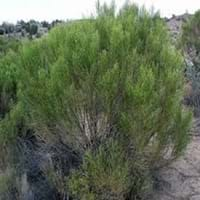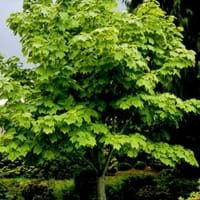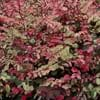Life Span
Perennial
Perennial
Origin
Hybrid origin, Southwestern United States
Northeastern United States, Mid-Atlantic United States, Southeastern United States, Canada
Types
Not Available
Not Available
Habitat
riparian zones, Semi desert, Upland
moist forests, Slopes
USDA Hardiness Zone
8-10
3-7
Sunset Zone
7, 8, 9, 10, 11, 12, 13, 14
Not Available
Habit
Spreading
Upright/Erect
Flower Color
White
Yellow, Yellow green
Flower Color Modifier
Not Available
Bicolor
Fruit Color
creamy white
Green, Brown
Leaf Color in Spring
Green
Light Green
Leaf Color in Summer
Green
Green
Leaf Color in Fall
Green
Yellow
Leaf Color in Winter
Green
Not Available
Leaf Shape
Oblanceolate , Ovate
Maple shaped
Plant Season
Spring, Summer, Fall, Winter
Not Available
Sunlight
Full Sun
Partial Sun, Partial shade
Type of Soil
Clay, Loam, Sand
Loam
The pH of Soil
Acidic, Neutral, Alkaline
Acidic, Neutral
Soil Drainage
Well drained
Well drained
Bloom Time
Spring
Early Spring, Spring
Tolerances
Drought, Dry soil, Heat Tolerance
Not Available
Where to Plant?
Ground, Pot
Ground
How to Plant?
Seedlings
Layering, Seedlings, Stem Cutting
Plant Maintenance
Medium
Medium
Watering Requirements
Needs very little water
Requires regular watering
In Summer
Lots of watering
Lots of watering
In Spring
Moderate
Moderate
In Winter
Average Water
Average Water
Soil pH
Acidic, Neutral, Alkaline
Acidic, Neutral
Soil Type
Clay, Loam, Sand
Loam
Soil Drainage Capacity
Well drained
Well drained
Sun Exposure
Full Sun
Partial Sun, Partial shade
Pruning
Cut back old stems to the ground, Remove damaged leaves, Remove dead branches, Remove dead leaves
Prune if you want to improve plant shape
Fertilizers
can go long without fertilizers
All-Purpose Liquid Fertilizer
Pests and Diseases
Pests and diseases free
Anthracnose, Bacterial leaf scorch, Bleeding canker, Decline, Fomes root rot, Ganoderma root rot, Laetiporus root rot, Leaf spot, Powdery mildew, Red blotch, Tar spot, Verticillium Wilt
Plant Tolerance
Dry Conditions, Dry soil, Heat And Humidity
Drought
Flowers
Showy
Insignificant
Flower Petal Number
Single
Single
Foliage Texture
Fine
Coarse
Foliage Sheen
Glossy
Matte
Attracts
Butterflies
Not Available
Allergy
Unknown
Asthma, Runny nose, Skin irritation
Aesthetic Uses
along a porch, deck or patio, Beautification, Ground Cover, Showy Purposes, Wild gardens
Showy Purposes
Beauty Benefits
Not Available
Not Available
Edible Uses
Sometimes
Yes
Environmental Uses
Air purification
Air purification
Medicinal Uses
anti-inflammatory, Anti-oxidant, cholesterol-lowering
Antirheumatic, Cold, Cough, Emetic, gonorrhoea, Kidney problems, Pectoral, Swelling, Vomiting
Part of Plant Used
Twigs
Leaves, Sap
Other Uses
Can be made into a herbal tea
Used as Ornamental plant, Used as preservative
Used As Indoor Plant
No
No
Used As Outdoor Plant
Yes
Yes
Garden Design
Groundcover
Feature Plant
Botanical Name
BACCHARIS 'Centennial'
ACER pensylvanicum
Common Name
desert broom , broom baccharis , greasewood
Moosewood, striped maple, moose maple
In Hindi
desert broom
धारीदार मेपल
In German
Wüste Besen
gestreifte Ahorn
In French
desert broom
érable rayé
In Spanish
escoba del desierto
arce rayado
In Greek
desert broom
ριγέ σφενδάμου
In Portuguese
vassoura do deserto
plátano listrada
In Polish
desert broom
paski klonu
In Latin
desert broom
alba acernis
Phylum
Magnoliophyta
Magnoliophyta
Class
Magnoliopsida
Magnoliopsida
Order
Asterales
Sapindales
Family
Asteraceae
Aceraceae
Clade
Angiosperms, Asterids, Eudicots
Angiosperms, Eudicots, Rosids
Tribe
Astereae
Not Available
Subfamily
Not Available
Not Available
Number of Species
Not Available
Not Available
Importance of Desert Broom and Moosewood Tree
Want to have the most appropriate plant for your garden? You might want to know the importance of Desert Broom and Moosewood Tree. Basically, these two plants vary in many aspects. Compare Desert Broom and Moosewood Tree as they differ in many characteristics such as their life, care, benefits, facts, etc. Every gardener must at least have the slightest clue about the plants he wants to plant in his garden. Compare their benefits, which differ in many ways like facts and uses. The medicinal use of Desert Broom is anti-inflammatory, Anti-oxidant and cholesterol-lowering whereas of Moosewood Tree is Antirheumatic, Cold, Cough, Emetic, gonorrhoea, Kidney problems, Pectoral, Swelling and Vomiting. Desert Broom has beauty benefits as follows: Not Available while Moosewood Tree has beauty benefits as follows: Not Available.
Compare Facts of Desert Broom vs Moosewood Tree
How to choose the best garden plant for your garden depending upon its facts? Here garden plant comparison will help you to solve this query. Compare the facts of Desert Broom vs Moosewood Tree and know which one to choose. As garden plants have benefits and other uses, allergy is also a major drawback of plants for some people. Allergic reactions of Desert Broom are Unknown whereas of Moosewood Tree have Asthma, Runny nose and Skin irritation respectively. Having a fruit bearing plant in your garden can be a plus point of your garden. Desert Broom has no showy fruits and Moosewood Tree has no showy fruits. Also Desert Broom is not flowering and Moosewood Tree is not flowering . You can compare Desert Broom and Moosewood Tree facts and facts of other plants too.





